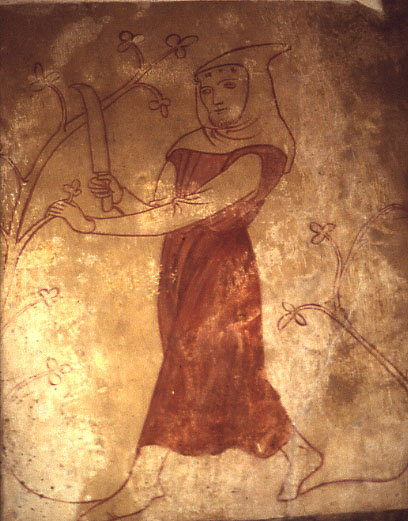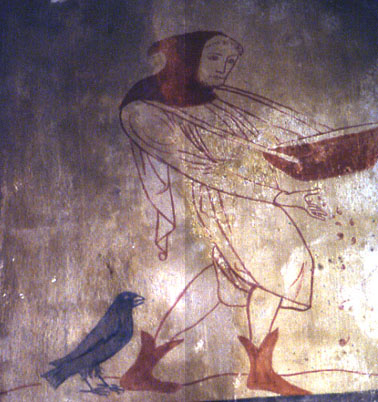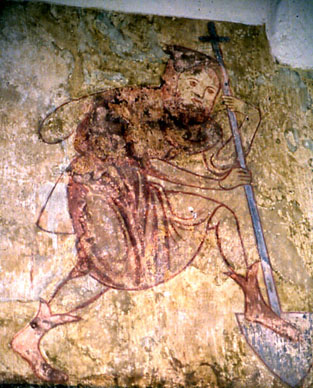Easby, N Yorkshire (†Ripon) C.13
The Labours of the Months

Not everything painted in the English Parish church has a religious theme, and along with much purely decorative painting, some secular subjects are found. The Labours of the Months is one such, and there might once have been many examples, but that at Easby is the only one recorded (a remaining fragment of another might be at Little Easton in Essex). There were presumably once twelve individual paintings in the series of Labours, one for each month, but only four, in window splays on the north wall of the chancel, remain.

At the left is Pruning, generally associated with October, although there are regional variations. More often than not, it is vines that are being pruned, as in this example. Vines were cultivated on many monastic estates, and in the warm 13th century this would have been perfectly feasible even as far north as Easby. In fact three of the four figures on this page appear to have tonsures, and although the parish church is earlier than, and entirely separate from, adjacent Easby Abbey¹ (substantial ruins of which remain), the paintings here might well reflect contemporary farming activities on the monastic estates.
At the right is Sowing – again attributed to various months according to region but perhaps meant for April here – showing a man scattering seed from a large bowl while a hopeful crow looks on.

The third Labour, pictured at the left, is Digging, with a man driving a shield-shaped spade with an oddly small handle into the ground, seemingly with some difficulty.
The fourth and sole remaining ‘Labour’ (shown below at the right) is unlike the others in that it represents Hawking, not normally thought of as a laborious activity in the same way as the previous three. Sometimes, though, the Labours of the Months are called simply the ‘Occupations’ of the months, and that title is perhaps more appropriate here. The Calendar of the famous Trés Riches Heures du Duc de Berry¹ has a hawking scene to represent August, and to judge by this young rider’s rather insubstantial clothing, August is very likely to be the intended month at Easby as well.

It is hard to be certain about the species of hawk on the young man’s right hand, but in the strict hierarchy of hawkers and their birds a hobby (falcon subbuteo) would be the appropriate one for a young man, and the bird’s size suggests that that is what it might be.
There were presumably once eight more Labours of the Months painted elsewhere in the church, but although these have gone there are many other paintings here, on the south side of the chancel. In a similar way to Chalgrove they tell the complete Christian story from the Creation to the Resurrection, but all the Easby paintings, including the Labours of the Months, were unfortunately very emphatically restored in Victorian times. The heavily linear, over-literal repainting is evident enough on this page, but it is unfortunately even more so in the other paintings, which will nevertheless be included on the site in due course.
Website for St Agatha’s, Easby
¹ Plate VIII, The Duc de Berry’s Book of Hours, Hallwag, Berne, 1962.
² Unusually, the abbey precincts actually surrounded the parish church (St Agatha), and the duties of the parish priest were performed by one of its Premonstratensian canons. But the abbey had its own, quite separate, church.